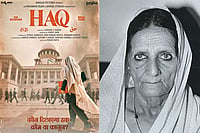Everyone will agree that Philip Larkin was one of the most influential English poets of the 20th century. They will also agree that, as a person, Larkin was nasty, brutish and tall. All imaginable abuses have been hurled at him—misogynist, sexual pervert, anti-Semite, racist, fascist, children-hater, homosexual, homophobic, coward, unpatriotic, hard, miser, pompous, condescending are but a few of them. James Booth’s loving biography goes on to prove in great detail how the charges can be refuted. It portrays him as a compassionate, if somewhat lonely and awkward in public, self-deprecating, generous and sensitive man.
Booth takes great, elaborate pains to right some of the wrongs about Larkin. For instance, on the charge that Larkin’s father Sydney was a Hitler sympathiser, that he had once said that his father “had a 12-inch statue of Hitler on the mantelpiece which at the touch of a button leapt into a Nazi salute”. Booth says that the object was a tiny hand-painted figurine, barely three inches high—the kind of souvenir which tourists to Germany in the ’30s would buy. Then again, about Larkin’s ‘ruthless and chauvinistic’ treatment of his first girlfriend, Ruth Bowman, with whom he had a relationship in his twenties, Booth has another explanation. He says we know of Larkin’s relationship with Ruth only through his own letters to his lifelong friend, author Kingsley Amis, in Anthony Thwaite’s Selected Letters (published in 1992, the book seems to be largely responsible for Larkin’s public fall from grace) and that these may be coloured by boyish bravado. Booth says we may never know how deep his relationship with her was as the 400-odd letters he wrote to her in their six-year affair were all burnt by her father.
This onerous task Booth has taken upon himself—to source every archival material and first-hand account to defend Larkin—can be daunting. By the middle of the book, the reader wants Booth to stop saving Larkin’s reputation as a person and instead write more about his art. Which he does and the real pleasure of the book is that Booth makes the reader live through the context and the influences of every poem Larkin ever wrote, sometimes every stanza.
Mantled in grey, the dusk steals slowly in,/Crossing the dead, dull fields with footsteps cold (...)/As quiet as death. The sky is silent too,/Hard as granite and fixed as fate. Larkin wrote these lines, from Winter Nocturnes, his first published poem, when he was 16. There is a detailed chapter on Larkin’s two novels, Jill and A Girl in Winter. In the end, Larkin is disappointed with both the books; he thinks Jill is inferior to Amis’s Lucky Jim, which came out around the same time, and concludes, interestingly, that writing prose is more difficult than writing poems. The chapters on Larkin’s Ireland days are rich and lovingly recreated, giving an insight into the artistic outpouring that was soon to follow.
One of the most fascinating parts of the biography is Larkin writing—in his twenties, as Brunette Coleman—college-girl lesbian love stories and poems. He has been derided for this too, some critics calling him a sexual deviant, but Booth goes on to explain the literary quality, refinement and boldness of some of Coleman’s poems. Like this: Stretched out before her, Rachel curls and curves,/Eyelids and lips apart, her glances filled/With satisfied ferocity, she smiles,/As beasts smile on the prey they have just killed.
The three sets of black-and-white photographs relating to various stages of Larkin’s life are a real treat. All the women in his life come alive in them. There is one of Ruth Bowman in 1948, when Larkin proposed to her, who is staring into the camera, face tilted towards one side, with the caption: “The engagement, to me anyway, is give myself a sincere chance of ‘opening out’ towards someone I do love a lot in a rather strangled way, and to help her take her Finals”. There are photos of Monica Jones (“beautiful handsome girl”); of library assistant Maeve Brenner; of Winfred Arnott, who inspired Lines on a Young Lady’s Photograph Album; Patsy Strang, a short affair with whom led to the poem Whatever Happened; and Judy Egerton, whom Larkin met in Belfast in 1951. Life, Art and Love leaves you remembering Philip Larkin more fondly than before, as Booth is very persuasive in making you change your mind about him, but more than that, it’s a great way to revisit all his poems, about which you can never change your mind.



























